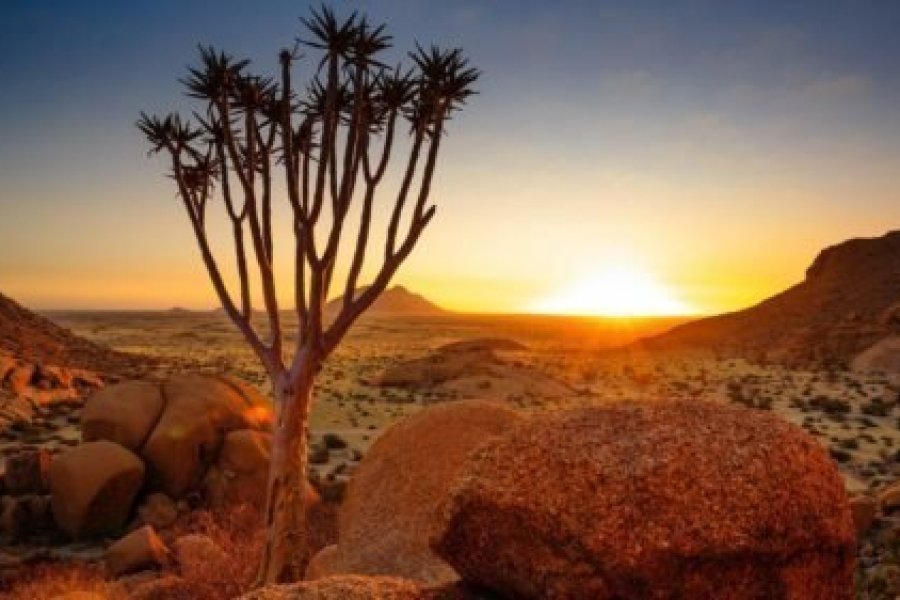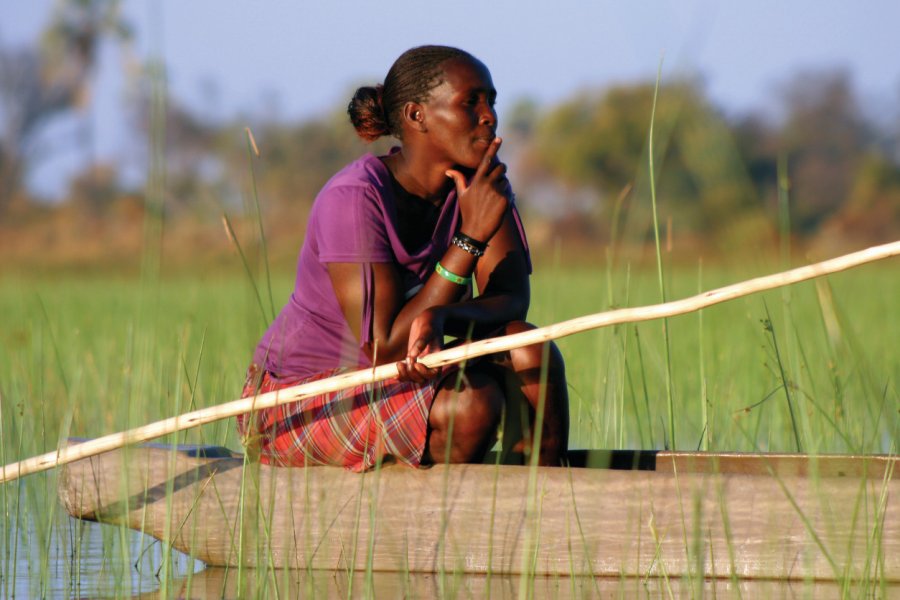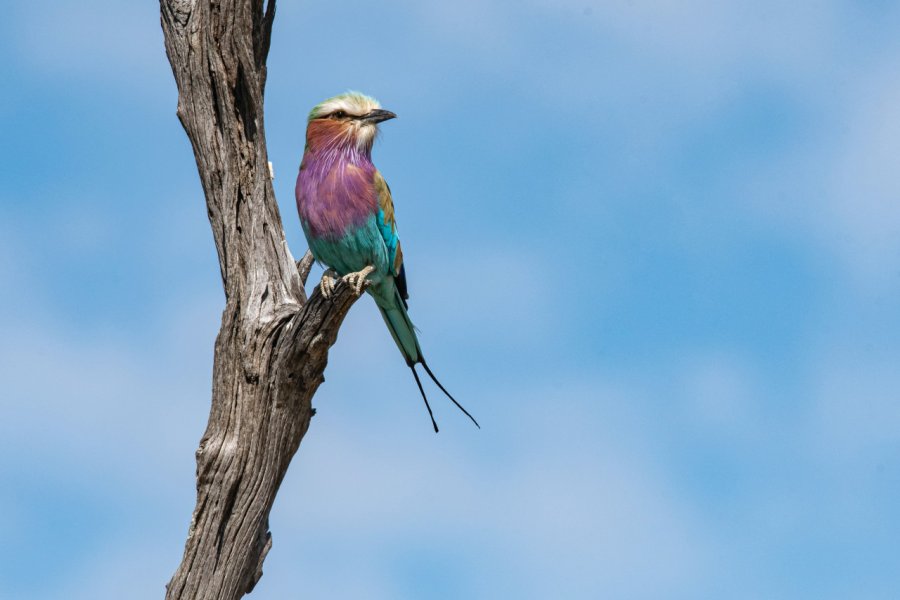Travel guide Botswana
Botswana (the country of the Tswana, named after its majority ethnic group) could have been home to the spectacular Victoria Falls, the pride of Zimbabwe and Zambia. A cartographic misadventure that does not prevent this destination from being one of the most popular on the African continent, especially for a wealthy clientele looking for high-end services in preserved and isolated environments. The Botswana territory is indeed covered in its great widths by immense desert spaces of which the Kalahari Desert is the first representative. But this flat southern African country is much more than a carpet of rock and sand and conceals many natural wonders to be discovered with a Botswana travel guide. The choice is vast: the Okavango Delta region, a real oasis in the desert, the four national parks of savannah and grassland, including the Chobe National Park and the Moremi National Park, or the many reserves such as the unique Central Kalahari. These reserves are all the richer for the fact that hunting has been banned there since 2014. Going on safari in Botswana is a guarantee to observe closely and in small groups all the animals of southern Africa, a wildlife populated by elephants (the highest concentration of the continent), giraffes, lions, antelopes, hyenas, elephants, zebras, hippos, rhinoceroses, leopards and crocodiles.
What to see, what to do Botswana?
-
Book an activity
-
Customized travel
- The most beautiful cities Botswana
When to go Botswana ?
Botswana is located in the southern hemisphere and the seasons are therefore reversed compared to Europe. Nevertheless, rather than talking about winter or southern summer, it is better to talk about the rainy season and the dry season to better organize your safari. The best time to go to Botswana is during the dry season, from May to October. The sun is always shining and it is the ideal time to observe the wildlife. From November to April, during the rainy season, the animals are more scattered but they are still visible on safari.
Suggested addresses Botswana
Travel Botswana
-
Find a hotel
-
Car Rental
-
International e-SIM package
-
Find a local agency
Du fabuleux delta de l'Okavango aux grands pans salés, en passant par le désert du Kalahari et les paysages accidentés du Tuli Block, le Botswana, resté en grande partie sauvage, offre une multitude d'itinéraires et de possibilités d'excursions qu'il faudrait y rester au moins un mois pour découvrir toutes ses richesses. Cependant pour visiter ces terres intactes, les voyageurs auront un choix fondamental à faire : self-drive ou tour-opérateur ? Seuls les plus aventuriers tenteront la découverte du pays en self-drive, dont le séjour en toute autonomie devra se préparer bien en amont et nécessiter d'une bonne maîtrise de la conduite tout-terrain. La très grande majorité des voyageurs choisira donc de faire appel aux services d'un ou plusieurs tour-opérateurs qui organisera leur séjour selon leur budget et leurs centres d'intérêt. Professionnels et souvent spécialisés, ils garantissent un voyage sur-mesure inoubliable !
Find unique Stay Offers with our Partners
How to go Botswana
How to go alone
There are almost no direct flights to the capital Gaborone and the easiest way is to stop over in South Africa. Therefore, plan at least 14 hours to arrive in Botswana. Please note that the price variation depends on the airline used but, above all, on the reservation delay. In order to get the best rates, it is essential to book well in advance. Think about buying your tickets six months before departure!
How to go on a tour
Botswana is not really a destination for backpackers unless you bring your own camping equipment and the country is best visited on a guided tour in top of the range lodges that will satisfy the most demanding. Safaris in Botswana are often offered as a package with a visit to the nearby Victoria Falls and a trip to Namibia.
How to get around
Botswana has an excellent road infrastructure that allows easy access by car or bus to all major tourist centers in the country. However, game reserves such as the Central Kalahari are only accessible by 4x4 or by air cab. The national airline, Air Botswana, also provides easy access to major cities. Other small airlines organize transfers from one city to another at more flexible dates but at slightly higher rates.
Featured articles Botswana
Discover Botswana
An arid territory coveted since prehistoric times, Botswana has seen successive waves of different ethnic groups settling in the country and getting along with each other as best they could throughout history. The arrival of the Protestant missionaries opened a new era with the peaceful evangelization of the population. Under British protection, the advances are less and the territory becomes prized for its mineral wealth. The tribal chiefs campaigned in England to defend their lands and obtained satisfaction. As soon as it became a republic, Botswana discovered its first diamond deposits and rapidly developed its infrastructure. The country has since prospered economically and is now a model of success in Africa. Aware of its remarkable nature, it is turning to luxury tourism in order to preserve its wild lands, populated by exceptional wildlife and offering safaris worthy of the scenes in The Lion King.
Pictures and images Botswana
The 12 keywords Botswana
1. Amarula
Very popular, this creamy liqueur can be enjoyed as a digestive as well as a dessert. It is made from the fruit of the marula tree, a member of the anacardiaceae family that grows in the north of the country. Elephants love this fleshy fruit, which is said to ferment directly in their stomachs. One too many marula and they're tipsy!
2. Boma
Once a week, villagers gather to share a local dinner, sing, dance and feast in good spirits. The boma designates both this meeting place, an open-air space built around a campfire, and the name of the evening. An old custom that is still perpetuated today throughout the country!
3. Donkey cart

Before the advent of the car and modern means of transport, the donkey was used as a draught animal for agriculture as well as a means of locomotion. The donkey cart is a plough pulled by one or more donkeys. Common in Kalahari towns, these picturesque carriages are still used to transport children to school.
4. Kgotla
Strongly rooted in Botswanan customs, the kgotla system is nothing other than participatory democracy. Although it has lost some of its vigor these days, the tradition lives on. It is in the kgotla that politicians make their campaign speeches and minor offences are tried.
5. Impala

This beautiful white-tailed and white-bellied bovid looks like a mixture of gazelle and antelope. It can be seen in almost every park and reserve in Botswana. It is not uncommon to hear a guide refer to it as "the fast food of Botswana", probably because its predators only eat one bite and are hungry again two hours later!
6. Mokoro
The mokoro is a canoe used by the Okavango people on the shallow waters of the delta. Traditionally made from wooden trunks, they are now constructed from fibreglass, with the environment in mind. Handling a mokoro is an art that relies on the precise management of balance and weight!
7. Pan
These are huge depressions, the remains of ancient dry lakes from the period when the country enjoyed a temperate climate. They can be found all over the Kalahari and the most famous, by their size and especially their whiteness, are those of Sowa and Ntwetwe.
8. Pula
A sacred term in the eyes of the Botswana people, this word has many meanings, but above all it refers to the beneficial rain. It is therefore natural that the national currency took this name in 1976 when it replaced the South African rand. It is also the word used to toast friends or to announce the arrival of a big event!
9. Greetings
The common greeting is a handshake. It is similar to ours, but differs in one important detail: here, it is appropriate to greet with both hands as a sign of respect. The second hand is placed under or on the forearm. There are some local variations with sets of handles that are very easy to pick up.
10. Sausage tree

The sausage tree or Kigelia africana is one of Botswana's most unusual trees. As its name suggests, it can be identified by its fruits: giant sausages that can measure over 50 cm in length and weigh up to 5 kg! These strange specimens fall unexpectedly. If you're a napper, you'd better refrain - it could cost you your head!
11. Sun Downer

This is the little aperitif that we have at sunset, after having tracked mammals and birds for several hours. A speciality of the top lodges, this convivial cocktail is held, as it should be, in the heart of the bush, at the intoxicating hour when the predators start to move in the red colours of the setting sun.
12. Zebra
Present in large numbers in Botswana, the zebra, although intelligent and harmless, has never been domesticated. It is undoubtedly this mixture of wild and gregarious character that seduced the people of Botswana to choose it as their national animal. The players of the national football team, who call themselves the Zebras, are also honouring it.
You are from here, if...
You've already eaten crocodile, impala, kudu, oryx or warthog, because bushmeat, although quite spicy, is a great source of protein for the day!
You'll know how to handle the mokoro, the pirogue that plies the shallow waters of the Okavango Delta, because if your balance and weight aren't right, you could fall overboard!
You're so familiar with the sight of elephants, giraffes and ostriches on the roadside that your reflex is to slow down in case one of them decides to cross, because you know that wildlife is unpredictable.
When speaking to strangers, you call them sister or brother, as a sign of respect and warm welcome to the person you're meeting.
You've been through so much bush that it holds no secrets for you, even at night!





























